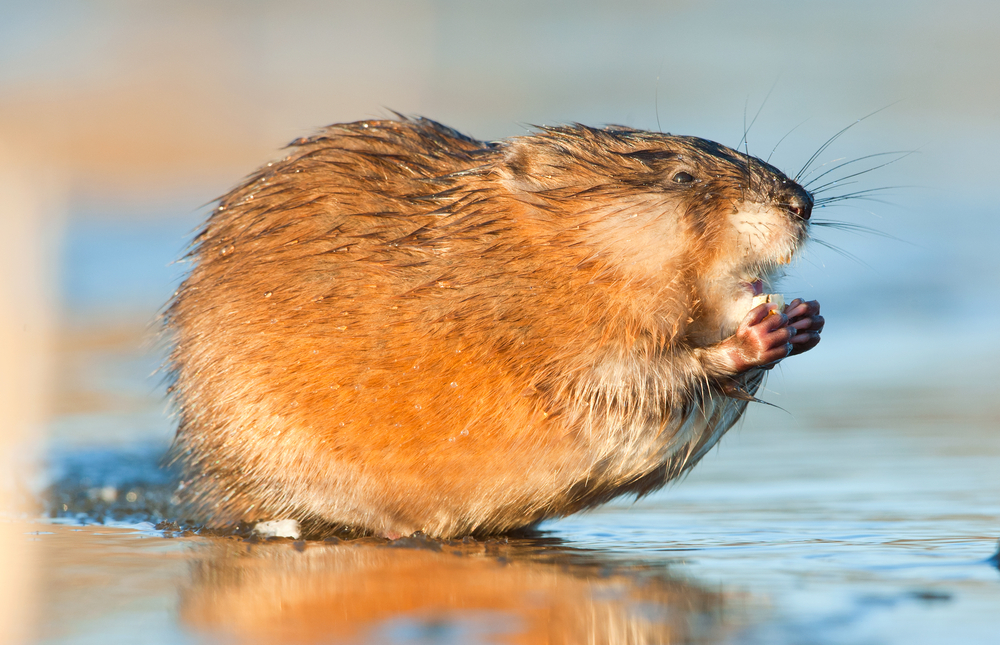Facts About Muskrats

Muskrats are large rodents, and therefore are related to rats, mice, voles, gerbils, hamsters and lemmings. These aquatic animals look a lot like their relatives. They are quite round, with short legs and almost invisible ears.
Size
Muskrats are around the size of large rats. They grow from 16 to 25 inches (41 to 63.5 centimeters) long and weigh around 1.5 to 4 lbs. (0.7 to 2 kilograms). Their tails add another 7 to 11 inches (18 to 28 cm) to their length, according to the Missouri Department of Conservation.
Habitat
The muskrat is native to North America. In the early 20th century, though, the animal was introduced to northern Eurasia, according to the Animal Diversity Web (ADW). They are now found in Ukraine, Russia, adjacent areas of China and Mongolia and the Honshu Island in Japan.
Muskrats like wetter areas with at least 4 to 6 inches (10 to 15 cm) of water. They typically make their homes in marshes, swamps and wetlands. They particularly like marshes.
Hot, dry weather is bad for muskrats, which is why they prefer wet areas and cool burrows dug on the banks of water sources. They even have a special mechanism, called regional heterothermia. Regional heterothermia regulates the flow of blood to the feet and tail. This keeps them cooler than the body's core.
In addition to burrows, muskrats also build lodges out of cattails and other vegetation. These lodges can sometimes clog up waterways, making them a nuisance to humans.
Habits
Muskrats are very social and live in large, territorial families, according to the ADW. They communicate with others and mark their territory with a secretion from their glands called musk. The scent serves as a warning to intruders.
Muskrats are considered nocturnal, though they are sometimes active during the day. Their most active times are late afternoon and right after dusk.
Diet
Muskrats aren't picky. In fact, they will even resort to cannibalism in their own family, according to the ADW. Mostly though, they tend to prefer vegetation like cattails, waterlilies, roots and pondweed. They also eat snails, mussels, salamanders, crustaceans, fish and young birds.
These small animals are very big eaters. Muskrats eat one-third of their weight every day, according to the ADW. Though they need a large supply of food, muskrats usually don't travel any farther than 150 feet (46 meters) away from their homes.
Offspring
Muskrats make their nests on tree stumps sticking out of 15 to 40 inches (38 to 102 cm) of water using vegetation. Females have a gestation period of three to four weeks and give birth to three to eight young, according to Encyclopedia Britannica. They can have up to three litters each year.
Baby muskrats are called kits. At 30 days old, kits can swim, dive and feed themselves. Kits are fully grown at six weeks and typically stay with their family, unless there is overcrowding. In this case, the mother will often kick the young out of the group.
These creatures can live around three years in the wild and up to 10 years in captivity.
Classification/taxonomy
Here is the taxonomy for muskrats, according to the Integrated Taxonomic Information System (ITIS):
Kingdom: Animalia Subkingdom: Bilateria Infrakingdom: Deuterostomia Phylum: Chordata Subphylum: Vertebrata Infraphylum: Gnathostomata Superclass: Tetrapoda Class: Mammalia Subclass: Theria Infraclass: Eutheria Order: Rodentia Suborder: Myomorpha Superfamily: Muroidea Family: Cricetidae Subfamily: Arvicolinae Genus: Ondatra Species: Ondatra zibethicus
Conservation status
Muskrats are listed as least concern on the International Union for Conservation of Nature's Red List of Threatened Species. This means that their populations are generally stable and widespread.
Though thought of as pests because they sometimes eat crops and block waterways with their lodges, muskrats are very helpful. By eating aquatic plants, they open other areas of the waterways, giving ducks and other birds clear places to swim. Their lodges are also used by other animals as resting areas and nests.
Other facts
The muskrat's dense fur traps air to keep them warm. It also helps them float in water.
Though not great on land, muskrats are fantastic swimmers. They can hold their breath under water for 12 to 17 minutes, according to the ADW. They can swim up to about 3 mph (5 km/h) thanks to their paddle-like webbed feet. Muskrats can even swim backward.
Additional resources
Sign up for the Live Science daily newsletter now
Get the world’s most fascinating discoveries delivered straight to your inbox.










